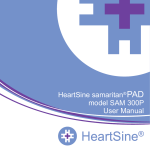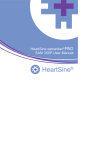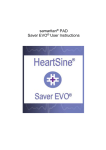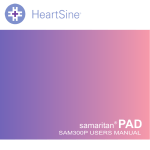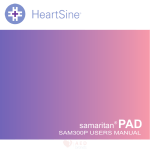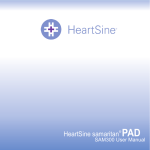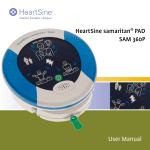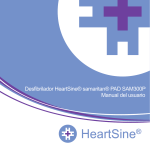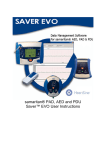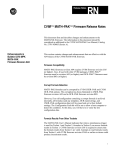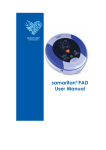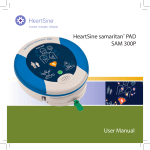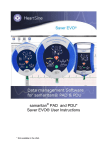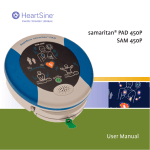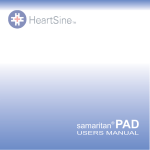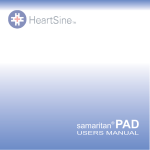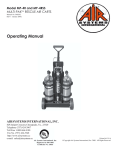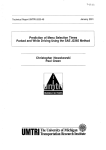Download User Manual - Frontline First Aid & Emergency Training
Transcript
HeartSine samaritan® PAD model SAM 300P User Manual HeartSine® Contents Introduction 1 samaritan PAD model SAM 300P configuration 2 CPR Guidelines 2010 3 Your samaritan PAD model SAM 300P 4 samaritan PAD model SAM 300P Features 5 Preparing Your samaritan PAD model SAM 300P For Use 6 Maintenance 7 ® ® ® ® When To Use The samaritan PAD model SAM 300P 10 Adult Or Pediatric (Child) Patient 11 CPR With Defibrillation (CPR-D) Fundamentals 12 Performing Defibrillation 14 After Using samaritan PAD model SAM 300P 16 Troubleshooting 17 Warnings And Precautions 18 Technical Data 19 SCOPE™ Biphasic Waveform 21 ECG Arrhythmia Analysis Algorithm 22 Guidance And Manufacturers Declaration 23 Glossary 25 ® ® About This Edition The information in this manual applies to the HeartSine Technologies samaritan PAD 300P automatic external defibrillators which have serial numbers where the first two digits are ”08” or above. Information in this document is subject to change without notice and does not represent a commitment on behalf of HeartSine Technologies. No part of this manual may be reproduced or transmitted in any form or by any means, electrical or mechanical, including photocopying and recording for any purpose without the express written permission of HeartSine Technologies. Copyright© 2011 HeartSine Technologies. All rights reserved. “samaritan” is a registered trademark of HeartSine Technologies. “SaverTM EVO”, and “SCOPE” are trademarks of HeartSine Technologies. All other trademarks and registered trademarks are the property of their respective owners. Symbol Definitions Note ! Warning Voice Prompt To Do 2 www.heartsine.com Introduction The SAM 300P The SAM 300P is an Automated External Defibrillator (AED) used for the fast delivery of defibrillation electric shock therapy to resuscitate victims of Sudden Cardiac Arrest (SCA). Sudden Cardiac Arrest (SCA) Sudden cardiac arrest is a condition in which the heart suddenly stops pumping effectively due to a malfunction of its electrical system. Often victims of SCA have no prior warning signs or symptoms. SCA can also occur in people with previously diagnosed heart conditions. Survival for SCA victims depends on immediate cardiopulmonary resuscitation (CPR). The use of an external defibrillator within the first few minutes of collapse can greatly improve the survival chances of a patient. Heart attack and SCA are not the same, though sometimes a heart attack can lead to an SCA. If you are experiencing symptoms of a heart attack (pain, pressure, shortness of breath, squeezing feeling in chest or elsewhere in the body), seek emergency medical attention immediately. Heart Rhythm The normal electrical rhythm, by which the heart muscle contracts to create blood flow around the body, is known as Normal Sinus Rhythm (NSR). Ventricular Fibrillation (VF), caused by chaotic electrical signals in the heart, is often the cause of SCA but an electrical shock can be administered to re-establish NSR. This treatment is called defibrillation. The SAM 300P is a device designed to automatically detect VF and perform defibrillation on victims of sudden cardiac arrest. Detecting Fibrillation The electrical rhythm by which the heart muscle contracts can be detected and used for medical diagnosis. The resulting reading is called an Electrocardiogram (ECG). The SAM 300P has been designed to analyze a patients ECG in order to detect VF in the heart. If VF is detected the SAM 300P will deliver a carefully engineered electrical shock designed to stop the chaotic electrical activity experienced within the heart muscle during SCA. This may allow the victim’s heart to return to a NSR. SAM 300P User Manual Training SCA is a condition requiring immediate emergency medical intervention. This intervention, due to the nature of the condition, can be performed prior to seeking the advice of a physician. In order to properly diagnose this condition, HeartSine recommends that all potential users of the SAM 300P, as a minimum, are fully trained in cardiopulmonary resuscitation (CPR), basic life support (BLS) and, in particular, the use of an Automated External Defibrillator, specifically the SAM 300P. It is also recommended that this training be kept up to date by means of regular refresher courses as and when recommended by your training provider. If potential users of the SAM 300P are not trained in these techniques, contact your authorized HeartSine distributor or HeartSine directly either of whom can arrange for training to be provided. Alternatively contact your local government health department for information on certified training organisations in your region. HeartSine Technologies recommend that users ! are trained in Cardiopulmonary Resuscitation and the use of a Defibrillator (CPR-D) Check with local government health department for information about any requirements associated with ownership and use of a defibrillator in the region where it is to be used. Store this manual with the SAM 300P (it will fit into the back section of the soft carry case). Ensure all potential users of the SAM 300P have read this manual and are familiar with its operation. Within the United States of America, federal ! (U.S.) law restricts this device to sale by or on the order of a licensed practitioner. Warranty Registration Under internationally agreed Medical Devices Regulations we are required to track the location of all medical devices sold. It is important that you complete the Warranty/Registration card and return it to your authorized distributor or HeartSine Technologies directly. Your participation will allow us to contact you in the event of important notifications about the SAM 300P such as any future software updates or field safety corrective actions. Please complete the Warranty/Registration card included with the SAM 300P. Registration is required to validate the product warranty. The information provided will be kept strictly confidential and will not be shared with other organisations. ! 1 samaritan® PAD model SAM 300P configuration The SAM 300P Label The SAM 300P can be identified by the “SAM 300P” and the image above on the front of the device. AHA/ERC 2010 guidelines HeartSine Technologies provides you with a fully configured system to allow you to comply with your chosen SCA treatment protocol. Our current device is configured to be compliant with the 2010 version of the American Heart Association (AHA)/European Resuscitation Council (ERC) guidelines on Cardiopulmonary Resuscitation (CPR) and Emergency Cardiovascular Care (ECC). You should be trained in the appropriate version of the AHA/ERC guidelines and the use of your device configuration. Contact your authorized HeartSine distributor or HeartSine directly for further Information. 2 www.heartsine.com CPR Guidleines 2010 The following is a brief overview of the fundamentals of CPR for lay rescuers as advised by both the American Heart Association (AHA) and the European Resuscitation Council (ERC) in their 2010 published Guidelines for CPR and ECC. This is intended only as a quick reference for trained CPR providers. HeartSine recommends that all potential users of the SAM 300P are trained by a competent training organisation in both the use of CPR and SAM 300P, prior to placing a SAM 300P into service. CALL Emergency Services (911/999/112 etc) Send for an AED Person not responsive? Address person and shake on shoulder Watch, feel, listen Open the airway, check for breathing 30 compressions 2 Breaths Perform CPR until an AED is available OR arrival of emergency physician Engage other people to help you and alternate CPR If AED is available switch on and follow instructions If available use an AED Analysis shock decision YES NO DELIVER SHOCK Continue CPR until Emergency Services arrive. Alternate with second person after one cycle or 2 minutes SAM 300P User Manual Continue CPR for 2 minutes/ 5 cycles 3 Your samaritan® PAD model SAM 300P Unpacking Your SAM 300P a. Open the outer box, remove the SAM 300P and all the accessories. b. Fill out the warranty/ registration card and return to Heartsine Technologies. c. Read this User Manual. d. Ensure all potential users are suitably trained. e. Place the SAM 300P into service. Warranty The SAM 300P is supplied with a fixed term warranty from the date of manufacture. Please check the enclosed warranty statement for details The year of manufacture of the device is indicated by the first two digits of the serial number. The Pad-Pak and Pediatric-Pak warranty extends to the expiry date stated on the pack. The Pad-Pak and PediatricPak should not be used beyond the stated expiry date. The expiry date is given beside the symbol shown below. The Pad-Pak and Pediatric-Pak are both single use items. If a Pad-Pak or a Pediatric-Pak are used on a patient they must not be used again. Warranty Exclusion HeartSine Technologies or the authorized distributor are not obliged to carry out service/repairs under warranty if: 4 a. Unauthorized modifications have been made to the device. b. Non-standard components are used. c. The user has not used the device in accordance with the indications for use or the instructions provided in this manual. d. The serial number of the device is removed, defaced, misused or altered. e. The device, electrodes or batteries are stored or used operationally outside of environmental specifications. f. Pad-Pak or Pediatric-Pak packaging is not returned. g. The device has been tested using unapproved methods or inappropriate equipment (see maintenance section). Any claims made under warranty must be directed via the distributor from whom the device was originally purchased. Before carrying out service under warranty, HeartSine Technologies require evidence of purchase. The product must be used in accordance with the user manual and for the purpose for which it was intended. If you have a query please contact [email protected] for assistance. Optional Data Management Package As an accessory HeartSine offers a Data Management cable for the SAM 300P. The cable, combined with SaverEVO software, allows users to download and manage recorded incidents from the memory of the SAM 300P. For further information on this optional accessory please contact your authorized HeartSine distributor or HeartSine directly. USB Port Data cable SaverTM EVO The SAM 300P should only be connected to an ! IEC60950 PC Do not defibrillate while SAM 300P is ! connected to the PC Software updates The software on the SAM 300P can be upgraded using the data management package. Software updates are available on our website (www.heartsine.com). www.heartsine.com samaritan® PAD model SAM 300P Features B A On/Off button Press this button to turn the device on and off. C D K Shock button Press this button to deliver a therapeutic shock. Status indicator When the indicator is flashing green the SAM 300P is ready for use. J E I H A B C D E F G H I J K G Data Port Status Indicator Shock Button Safe To Touch Indicator Speaker Pad-Pak Cartridge On/Off Button Do Not Touch Indicator Pads Placement Indicator SAM 300P label Action Arrows SAM 300P User Manual F Attach PADs indicator The action arrows around this icon will flash to instruct the user that the SAM 300P pads should be attached to the patient as indicated. Safe To Touch indicator It is safe to touch the patient when the action arrows around this icon are flashing. You may perform CPR or check the patient. Do Not Touch indicator Do not touch the patient when the action arrows around this icon are flashing. The SAM 300P may be analysing the patients heart rhythm or preparing to deliver a shock. Action arrows The action arrows around an icon will flash to indicate the actions that the user should be performing. 5 Preparing Your samaritan® PAD model SAM 300P For Use Pad-Pak™ Installation The Pad-Pak includes the battery and defibrillation electrodes in one cartridge. See expiry date on label. Installation 4 - SAM 300P Storage Put into a wall case or other safe visible location. Wall cases differ in some countries. Contact your authorized HeartSine distributor or HeartSine directly for more information. The SAM 300P should be kept in a convenient central location. Ideally keep it alongside other emergency equipment such as first-aid, CPR preparation kits or fire extinguishers etc. If possible these should be located close to a telephone so that the rescuer can call emergency services and retrieve the SAM 300P without wasting time. Some important points to remember when selecting a storage location for the SAM 300P: Installation 1 Remove the Pad-Pak from its packaging and place the SAM 300P and the Pad-Pak on a flat surface. Push Pad-Pak into the opening and listen for the “click” sound to ensure it is properly inserted. Once the Pad-Pak is installed properly the Status indicator will begin to blink green every 5 seconds. Do not open Pad-Pak tray or open defibrillation pads protective packaging until they are required in an emergency. a. Ensure the SAM 300P can be retrieved easily at any time. HeartSine recommend that the location selected should not be locked as finding key holders may delay the provision of therapy. b. The location selected should be clean and dry. Avoid using locations which may be damp or dusty. c. The location should be maintained at a temperature between 0°C and 50°C(32°F to 122°F). Do not select locations which may expose the defibrillator to extreme temperatures even if this is for small amounts of time. Call for medical assistance d. Where possible the SAM 300P should be stored along with other appropriate CPR accessories such as; CPR mask, razor, scissors etc. Switch Off by pressing OFF Button e. Ensure that the SAM 300P status indicator can be seen. f. Make all necessary arrangements to ensure that the device is accessible at all times. Inform any possible users of the location of the SAM 300P. Installation 2 - Test SAM 300P Push the ON Button. Ensure you can hear the voice prompts: Adult patient / Child patient Installation 3 Place the SAM 300P into its Soft Carry Case. For alternative transport cases please contact your authorized HeartSine distributor or HeartSine directly. 6 ! HeartSine recommends that a spare Pad-Pak is kept with your SAM 300P. A spare Pad-Pak can be stored in the back section of the SAM 300P Soft Carry Case. Contact your authorized HeartSine distributor or HeartSine directly to order spare or replacement Pad-Paks. www.heartsine.com Maintenance The SAM 300P contains no user serviceable parts, therefore an annual service is not required. HeartSine recommends users perform regular maintenance checks. A suggested maintenance check would be: a. Check the Status Indicator. If the Status Indicator is not flashing or is flashing red a problem has been detected. Refer to the troubleshooting section of this manual P17. b. Check the expiration date of the Pad-Pak currently inserted. If the Pad-Pak has exceeded its use by date, remove it and replace with a new Pad-Pak. Contact your authorized HeartSine distributor or HeartSine directly for replacements. c. Check supplies, accessories and spares for damage or expiration. Replace any accessories found to be damaged or that have exceeded their expiration date. d. Check the exterior of the SAM 300P for cracks or other signs of damage. Contact your authorized HeartSine distributor or HeartSine directly if any damage is found. e. Check that trained responders are aware of the SAM 300P’s location and that it is easily accessible for those responders at all times. f. Ensure all trained responders have up to date training for both CPR and AED use. For recommended retraining intervals please consult the organisation or body used to provide the training. Self Test The SAM 300P includes an automatic self test which is performed on a weekly basis. The self test program will run automatically and requires no user interaction. The SAM 300P performs a self-test routine at midnight GMT on Sunday. During this self test period, the status light will blink red. The status light shall return to green on successful completion of the self-test routine. The self-test will take no more than 10 seconds to complete. The flashing green LED indicates that the device is ready to use. Upon completion of self test the SAM 300P will emit a “beep”. The self test program will test your SAM 300P and ascertain if its functions are running. If the self test should fail then the LED will flash red and the device will emit a “beep” approximately once every 5 seconds. Self test is not able to determine if the battery and defibrillation pads currently inserted in SAM 300P are within their use by date. Remember to check the expiry date on the Pad-Pak. SAM 300P User Manual Status Indicator The SAM 300P includes a status indicator. This is an indicator which will flash green approximately once every five seconds. When it is flashing green it is an indication that the SAM 300P is ready for use. If this indicator is flashing red or not flashing there is a problem with your SAM 300P. If this is the case please refer to the troubleshooting section for further guidance and fault finding advice. This is an indicator which will flash green approximately once every five seconds. When it is flashing green it is an indication that the SAM 300P is ready for use. Check that the SAM 300P status indicator can be seen easily. Ensure that it is flashing green approximately once every 5 seconds. It is not necessary to power up your SAM 300P to check the status. ! The SAM 300P performs a self test routine at midnight GMT on Sunday. During this self test period the status light will blink red. The status light shall return to green on successful completion of the self test routine Regularly Turning On Device HeartSine recommends that users do not activate the SAM 300P on a regular basis to check its functionality. Regularly turning it on is not necessary as the status indicator informs the user if there is a problem with the SAM 300P. Please note: Every time the SAM 300P is turned on it uses power from the battery contained in the Pad-Pak. Continued regular periodic activation of the device to check functionality may reduce the standby life of your Pad-Pak resulting in the need for premature replacement. When the SAM 300P is switched on the event recording facility is activated. Switching on repeatedly will deplete the memory and could lead to insufficient memory to record a defibrillation event. The memory can be erased from the SAM 300P using SaverTM EVO software. 7 Maintenance Replacing The Pad-PakTM The battery lifetime in use can be up to 6 hours monitoring, 60 shocks or a combination of both. A Pad-Pak in stand by mode (inserted into the SAM 300P) has a shelf-life indicated by the expiry date* on the Pad-Pak. The Pad-Pak must be replaced out if: Check The SAM 300P Contact Pins When changing the Pad-Pak, HeartSine recommends that users check the contact pins on the SAM 300P. These pins are spring loaded and will retract when the Pad-Pak is inserted. The picture shown below shows how the contact pins on the SAM 300P look when the Pad-Pak has been removed. The expiry date of the Pad-Pak has been exceeded The Pad-Pak has been used (it is a single use item) If the status indicator on the SAM 300P is flashing red or not flashing you may need to replace the Pad-Pak. For diagnosis of the reason for the status indicator flashing red or not flashing please refer to the troubleshooting section of this manual. How To Replace A Pad-PakTM a. Take the replacement Pad-Pak from its protective bag. b. Remove the old Pad-Pak which is to be replaced. c. Follow the instruction for Pad-Pak installation which can be found on page 6. d. Push the Pad-Pak firmly to ensure it is fully inserted. e. Check status indicator. If the Pad-Pak has been inserted correctly, status indicator flashes green approximately every 5 seconds. f. Press the On/Off button to turn the device on. Listen for the appropriate messages to start. Press the On/Off button again to turn the device off. Ensure no warning messages are issued by the device and that the status indicator continues to flash green approximately once every five seconds. g. If necessary inform the person responsible for maintenance of the SAM 300P. h. Update the relevant records to show the date that the replacement Pad-Pak was placed into service. i. Dispose of the old Pad-Pak. To ensure proper operation, using your finger press lightly on each of the four pins in turn. Each pin will push back into the SAM 300P. Check that each pin springs back after it has been released. Testing The SAM 300P The Self Test function of the SAM 300P will determine if the device is ready for use. The SAM 300P should not be tested using standard ECG simulators. ! Testing the SAM 300P with unapproved testing equipment may damage the device and will invalidate your warranty. Contact your authorized HeartSine distributor or HeartSine directly for details on how to get your SAM 300P tested. * With one installation test and no additional activation 8 www.heartsine.com Maintenance Operating/ Standby Conditions The SAM 300P is intended to be stored at a temperature between 0°C to 50°C (32°F to 122°F). HeartSine recommends that if possible the device is stored at a comfortable room temperature as this will ensure the peak performance for both the SAM 300P and the Pad-Pak. samaritan® PAD Soft Carry Case The SAM 300P and Soft Carry Case have been designed to allow the rescuer to use the device without having to open the SAM 300P carry case. Do not store HeartSine products in locations where • moisture or condensation forms on surfaces. • excessive temperature fluctuations may be experienced, even if the temperatures are maintained within the ambient temperatures stated above. ! Ensure that the storage location is maintained at a temperature in the range of 0°C to 50°C, (32°F to 122°F). Long term storage outside this temperature range may adversely affect the performance of the device. When using the samaritan® PAD at the lower end of the recommended temperature range HeartSine recommends that it is not exposed to the lower temperatures until it is about to be used. Shipping And Transportation Temperature The SAM 300P may be temporarily stored in the range -10°C to 50°C (14°F to 122°F) for up to two days. If you believe that the SAM 300P has been stored below 0°C (32°F) it should be returned to an ambient temperature of between 0°C to 50°C (32°F to 122°F) for a period of at least 24 hours before the device is considered ready for use. ! The SAM 300P is not intended to be used in ambient temperatures below 0°C (32°F) or above 50°C (122°F). On Board Temperature Sensor The SAM 300P incorporates a temperature sensor. When the SAM 300P is turned on it will check the ambient temperature of the device. The SAM 300P will detect if it is outside of its intended storage temperature range of 0°C to 50°C (32°F to 122°F) by emitting three beeps when turned off. Front view A clear plastic cover protects the SAM 300P while allowing the rescuer to operate the unit. If your SAM 300P is stored in the soft carry case it is not necessary to remove it from the case to operate it. Pull green tab to expose electrodes package. Cleaning The samaritan® PAD To clean the SAM 300P wipe the device with a soft cloth that has been dampened by one of the following: Soapy water. Isopropyl alcohol (70% solution). ! ! SAM 300P User Manual Back view - With clear window for quick start card Do not immerse any part of the SAM 300P in water or any type of fluid. Contact with fluids may seriously damage the device, cause fire or shock hazard. Do not clean the SAM 300P with abrasive materials, cleaners or solvents. 9 When To Use The samaritan® PAD model SAM 300P When To Use The SAM 300P The HeartSine samaritan® PAD is designed for the treatment of sudden cardiac arrest (SCA). It should only be used to treat someone who may be a victim of a SCA and is: Unresponsive to stimulus Not breathing normally. No apparent circulation. If the person is unresponsive but you are unsure that they have suffered from a SCA begin CPR. When appropriate apply the defibrillator and follow the audible instructions. ! The SAM 300P has been designed to work on unconscious, non-responding patients. If the patient is responsive or conscious do not use the SAM 300P to provide treatment. Pre Defibrillation Actions Prior to using a SAM 300P it is advised to perform the following checks and actions in order to prepare the patient: Remove clothing to expose bare chest. All clothing must be removed including ALL undergarments. If excessively hairy, shave hair from the areas to which the defibrillation pads are to be applied. Ensure that the patients chest is dry. If necessary dry the chest area. Ensure no rescuers or bystanders are in contact with the patient while the SAM 300P is assessing the patients’ heart rhythm or while defibrillation shock is being applied. 10 www.heartsine.com Adult Or Pediatric (Child) Patient Adult Or Pediatric (Child) Patient The SAM 300P is capable of providing therapy to either adult or pediatric (child) victims of SCA. Patients who are less than eight years old and weigh less than 25 kilograms (55 pounds) should be treated as a pediatric patients. For use on pediatric patients remove the Adult Pad-Pak and insert a Pediatric-Pak into the SAM 300P. Full pediatric user instructions are provided with the Pediatric-Pak. ! Pad-Pak™ or Pediatric-Pak™ Patient HeartSine Technologies have developed two versions of the Pad- Pak. The standard Pad-Pak is intended to be used with suspected victims of SCA who are over eight years old or weigh more than 25kg (55lb). The Pediatric-Pak (child) is intended for use on suspected victims of SCA who are over one year old and less than eight years old weighing less than 25kg (55lb). The Pediatric Pak with electrodes opened is pictured below. HeartSine Technologies recommend a Pediatric-Pak is kept with the SAM 300P when the device is deployed in locations where children under the age of eight may frequent. If the patient is more than 25 kilograms (55pounds) in weight they should be treated as an adult patient. For adult patients the adult Pad-Pak should be used in the SAM 300P. ! Do not delay treatment trying to find out the patients exact age and weight. If a Pediatric-Pak is not available and an alternative defibrillator with pediatric capabilities can not readily be found the American Heart Association and European Resuscitation Council guidelines suggest to continue to defibrillate using an adult system. HeartSine recommend that the SAM 300P is kept with a PadPak (adult) inserted in preparation for use on adult patients. The Pad-Pak (adult) and Pediatric-Pak (child) can be quickly differentiated by both colour and shape. Please familiarize yourself with the alternative battery and electrode cartridges so that you can select the appropriate version in an emergency. ! Ensure you are familiar with the instructions on how to change a Pad-Pak™. When inserted into SAM 300P the Pediatric-Pak will protrude from the bottom of the samaritan® PAD as shown above. SAM 300P User Manual 11 CPR With Defibrillation (CPR-D) Fundamentals 1. Safety 2. Not responsive? No sign of life? Check breathing, open airway 4. Perform CPR until a PAD is available 3. Contact emergency services 30:2 911/999/ 112 etc ! Remove patient from risk area. Be aware of your own safety! 5. Switch on and follow instructions Engage other people to help you. Get PAD 6. Remove Clothes 7. Open Pad-Pak, remove pads, peel pads from liner. Apply pads to bare chest as shown below If necessary shave chest at electrodes site. Dry Skin 8. Follow Instructions 9. EITHER Press shock button OR Perform CPR for 2 minutes or 5 cycles 30:2 Alternate with second person after one cycle until professional rescue service arrives. 12 www.heartsine.com Performing Defibrillation Step 1 Call for medical assistance Step 2 Lay the SAM 300P on a flat surface ! To safeguard against interference you must operate the SAM 300P at least 2m (6 feet) away from all radio frequency devices and other susceptible equipment. Alternatively switch off equipment affected by or causing the electromagnetic interference Step 5 Remove clothing to expose the patient’s chest. If the patient has an excessively hairy chest, shave the area where the electrodes are about to be applied. Peel pads from liner Step 3 Apply pads to patient’s bare chest as shown in picture Press ON/OFF Button and open the green tab of the soft carry case. Listen for the audio prompts: Adult patient or Child patient Call for medical assistance Remove clothing from patients chest to expose bare skin Step 4 Press pads firmly to patient’s bare skin Place the electrodes on the patients chest as indicated below. Sternum and Apex electrode pads are clearly identified on the respective electrodes. Pull green tab to remove pads Grip the second green tab of Pad-Pak and PULL. SAM 300P User Manual Press the electrodes firmly to the patient’s bare chest to ensure proper contact is made. 13 Performing Defribrillation Step 6 When the electrode pads are attached correctly to the patient you will hear the audio prompts: Assessing heart rhythm Step 7 If the patient requires a therapeutic shock the SAM 300P will start to charge. In such a scenario you will hear the following prompts: Shock advised Do not touch the patient Stand clear of patient Stand clear of patient ! The Do Not Touch indicator (above) on the samaritan® PAD will be illuminated. The SAM 300P delivers electrical shocks which can cause serious harm to operators and bystanders. Caution must be taken to ensure no-one is in contact with the patient when a shock is delivered. Step 8 When the SAM 300P has charged to the required level you will hear the audio prompt: Press Shock button now Follow audio guidance. Do not touch patient or allow others to touch patient while the SAM 300P is analyzing. After completion of analysis the SAM 300P will advise you of treatment recommended. Care must be taken to keep patient still. A moving patient can lead to incorrect, delayed or less effective diagnosis and therapy. ! ! 14 Touching the patient during the analysis phase of treatment can cause interference with the diagnostic process which may cause increased analysis time. Avoid contact with the patient while analysis is being carried out. The device will instruct you when it is safe to touch the patient. Placement of the pads is critical. Strict observance of pad positioning instructions, as indicated on the labeling and in training, is essential. Failure in pad adhesion may hinder effectiveness of therapy or cause excessive skin burns to the patient if a therapeutic shock is applied. Above left is the Do Not Touch indicator. When you are certain that no one is touching the patient press the shock button (above right) to deliver the therapy. ! The SAM 300P will only administer a shock if it is needed. A voice prompt will tell you when to press the shock button to administer defibrillation therapy. www.heartsine.com Performing Defibrillation Step 9 When the shock has been delivered or ECG analysis has stopped you will hear the audio prompts: Your authorized HeartSine distributor will have trained you in the particular SCA treatment protocol you have chosen. In all cases, follow the audio and visual prompts given by your SAM 300P. Begin CPR It is safe to touch the patient Begin CPR immediately. Use the metronome sound from the SAM 300P for compression rate – the unit emits a tone at a rate compliant with current AHA/ERC guidelines. Note too that the Safe To Touch indicator flashes (above) at the same rate for additional guidance. As you start to provide CPR compressions the SAM 300P will continue to provide coaching on CPR with the following prompts issued. User And Bystander Safety As long as the defibrillator is used according to the directions, and no one is in contact with the patient when the Shock button is pressed, there is no risk of harm to the rescuer or bystanders. The SAM 300P cannot deliver a shock unless electrodes are applied to someone who exhibits signs of suffering from cardiac arrest and whose heart is in need of a shock. ! ! Place overlapping hands in middle of chest Press directly down on the chest in time with the metronome. ! Remain calm Step 10 The SAM 300P will remain in CPR mode for 2 minutes. After 2 minutes of CPR you will hear the following voice prompt: ! SAM 300P User Manual The Pad-Pak must be used on patients over 8 years old. The Pediatric-Pak must be used on patients less than 8 years old. Do not delay treatment through trying to find out the age and weight of the patient. It has been determined that the SAM 300P is safe to use in conjunction with oxygen mask delivery systems. However, due to the danger of explosion it is strongly advised that the SAM 300P should not be used in the vicinity of explosive gases. This includes flammable anaesthetics or concentrated oxygen. See Warnings and Precautions for complete list of warnings and precautions. Stop CPR The SAM 300P will then return to Step 6. Ensure no-one is in contact with the patient and proceed as before. Follow the voice prompts until the emergency medical services arrive. Do not touch the patient while the SAM 300P is in the process of delivering defibrillation therapy. Defibrillation energy can cause injury. Incident Notification As a user of an AED it is essential that you inform HeartSine Technologies of any incident where your SAM 300P is suspected to have caused a death, serious injury or illness. If you have any suspicions that this is the case you must inform HeartSine Technologies directly or through your authorized distributor. 15 After Using samaritan® PAD model SAM 300P Post Use Checklist Disposal Instructions After using your SAM 300P HeartSine Technologies recommends you perform the following actions: SAM 300P The SAM 300P is a reusable device. If maintained in accordance with the instruction in this manual it has a warranty period according to the warranty statement included with the device. The year of manufacture of the device is indicated by the first two digits of the serial number. Disposal If you wish to dispose of the SAM 300P unit, it should be disposed of at an appropriate recycling facility according to national, state and local requirements. Alternatively return the unit to your local distributor or HeartSine Technologies for disposal. Within the European Union Do not dispose of the SAM 300P unit as unsorted municipal waste. Collect the SAM 300P separately to be reused or recycled in accordance with Directive 2002/96/EEC of the European Parliament and the Council of the European Union on Waste Electronic and Electrical Equipment (WEEE), or return to your local distributor or HeartSine Technologies for disposal. Pad-PakTM The Pad-Pak is a single use accessory and must be replaced after use or at its expiry date. The Pad-Pak may be disposed of in accordance with the instructions for the SAM 300P unit. However special consideration must be given to the battery and defibrillation electrodes contained within the device. Alternatively, please contact your local distributor to organise the disposal of the Pad-Pak. Battery The Pad-Pak battery must be recycled separately in accordance with your national, state and local regulations. Please contact your local distributor or HeartSine Technologies to organise disposal. Electrodes When disposing of a used Pad-Pak, the defibrillation electrodes may be contaminated with human bodily tissue, fluid or blood. Detach the electrodes from the Pad-Pak. Place the electrodes together. The electrodes must be disposed of separately as an infectious waste material. Dispose of this material in accordance with your national, state and local regulations. If the Pad-Pak electrodes have not been used they may be considered non infectious waste. a. For data download please contact your authorized HeartSine distributor or HeartSine directly. b. Remove the used Pad-Pak from your SAM 300P and dispose of in a suitable manner. (For recommended disposal methods please refer to disposal instructions section) c. Check the exterior of the SAM 300P for cracks or other signs of damage. Contact your authorized HeartSine distributor or HeartSine immediately if any damage is found. d. Check the exterior of the SAM 300P for dirt or contamination. If needed clean device with approved cleaning products. e. Check supplies, accessories and spares for damage or expiration. Replace immediately if any damage or expiration is found. Contact your authorized HeartSine distributor or HeartSine directly. f. Install a new Pad-Pak. Before installing the new Pad-Pak check the expiry date. Refer to the Pad-Pak installation section for full instructions. g. After installation of the new Pad-Pak, check the status indicator. If the status indicator is not flashing green refer to the troubleshooting section of this manual. If the problem persists, contact your authorized HeartSine distributor or HeartSine directly for technical support. h. Turn on the SAM 300P and verify that the SAM 300P operates in the correct manner i.e. audible prompt “Call for medical assistance” can be heard. Turn off the SAM 300P. i. Contact HeartSine Technologies after use. At HeartSine we like to hear from our customers whenever they have any occasion to use any of our products, even if therapy is not delivered as part of the incident. This information is vital to the continued development and constant improvement we strive for in the treatment of SCA. 16 www.heartsine.com Troubleshooting Fault Identification If the SAM 300P detects a problem, it will indicate to the user that there may be a problem by two ways. Status indicator This should flash green approximately once every five seconds. If it is flashing red or not flashing at all, there may be a problem. Refer to troubleshooting section for further advice. (see maintenance section for details). Warning message. While turned on, the SAM 300P may play audible warning messages to indicate that there may be a problem. These messages are: Troubleshooting The following is brief set of instructions of what to do if you suspect a fault on the SAM 300P or if the SAM 300P gives an indication that there may be a fault (see fault identification section). a. Check the expiry date of the Pad-Pak battery. If the expiry date has been exceeded, change the Pad-Pak immediately. For replacement and spare Pad-Paks contact your authorized distributor or HeartSine Technologies. b. Ensure that the Pad-Pak has been correctly installed. Press the Pad-Pak firmly into place. Turn the device on and let the first audible message play. Turn the device off. If the SAM 300P plays no warning messages and the status indicator is flashing green, then the samaritan PAD can be returned to service. c. Turn the SAM 300P on. Listen for the appropriate voice prompts. Turn the SAM 300P off. Ensure no warning messages are played. Check that the status indicator is flashing green. If there have been no warning messages and the status indicator is flashing green, you may return the SAM 300P to service. d. Check for any signs of physical damage such as cracks in the plastic. If any are found, remove the SAM 300P from service and contact HeartSine Technologies or your authorized distributor for further advice. e. Change the Pad-Pak. Again try turning the device on and off. If no warning messages are heard and the status indicator is flashing green, then you may return the SAM 300P to service. Leave the working Pad-Pak in the SAM 300P. Contact your authorized distributor or HeartSine Technologies directly with details of the fault. Warning - Memory Full This message indicates that the memory for the event recording facility on the SAM 300P is full. The therapeutic capabilities of the device will be unaffected but it will no longer be able to record information for any incident it is used in. If you hear this message during an emergency response continue to use the SAM 300P until emergency services arrive. Warning - Low Battery This message indicates that the battery in the Pad-Pak may have less than ten defibrillation shocks left. If you hear this message during an emergency response, continue to use the SAM 300P until emergency services arrive. If available, prepare the spare Pad-Pak for use and be prepared to change it quickly. Warning - Device Service Required This warning indicates that the SAM 300P has detected a fault. Contact your authorized distributor or HeartSine Technologies directly for further instruction. If you hear this message during an emergency response, seek an alternative defibrillator immediately. SAM 300P User Manual If this fails, or if for any reason, you have suspicions that your SAM 300P is not working correctly, contact your authorized distributor or HeartSine Technologies directly for support. ! The SAM 300P contains no user serviceable parts. It is not safe for users to attempt to open it or any of its accessories. Opening the device will nullify all warranties. 17 Warnings And Precautions ! ! ! ! ! ! ! ! ! 18 HeartSine Technologies recommend that users are trained in Cardiopulmonary resuscitation with defibrillator use (CPR-D). Check with local government health department for information about any requirements associated with ownership and use of a defibrillator in the region where it is to be used. Within the United States of America federal (U.S.) law restricts this device to sale by or on the order of a licensed practitioner. The SAM 300P has been designed to work on unconscious, non-responding patients. If the patient is responsive or conscious do not use the SAM 300P to provide treatment. The SAM 300P has the capability to deliver therapeutic electrical shocks. The electrical shock can cause serious harm to either operators or bystanders. Caution must be taken to ensure that neither the operators nor bystanders touch the patient when a shock is to be delivered. To safeguard against interference you must operate the SAM 300P 2 meters (6 feet) away from all radio frequency devices and other susceptible equipment. Alternatively switch off equipment affected by or causing electromagnetic interference. Touching the patient during the analysis phase of treatment can cause interference with the diagnostic process which may cause increased analysis time. Avoid contact with the patient while analysis is being carried out. The device will instruct you when it is safe to touch the patient. It has been determined that the SAM 300P is safe to use in conjunction with oxygen mask delivery systems. However, due to the danger of explosion it is strongly advised that the SAM 300P should not be used in the vicinity of explosive gases. This includes flammable anaesthetics or concentrated oxygen. Proper placement of the SAM 300P pads is critical. Strict observance of pad positioning instructions, as indicated on the labelling and in training, is essential. Care must be taken to ensure pads are adhered to the patients’ skin properly. Air pockets between the adhesive pad and skin must be eliminated. Failure in pad adhesion may hinder effectiveness of therapy or cause excessive skin burns to the patient if a therapeutic shock is applied. ! ! ! ! ! ! ! ! ! ! ! ! ! The SAM 300P will only administer a shock if it is needed. A voice prompt will tell you when to press the shock button to administer defibrillation therapy. The Pad-Pak must be used on patients over 8 years old. The Pediatric-Pak must be used on patients less than 8 years old. Do not delay treatment trying to find out the patients exact age and weight. The Pad-Pak is a single use item and must be replaced after each use or if pouch that seals defibrillation pads has been broken/compromised in any way. If damage is suspected the Pad-Pak must be replaced immediately. HeartSine Technologies recommend that an additional spare Pad-Pak is kept with your SAM 300P Ensure you are familiar with the instructions on how to change a Pad-Pak. Ensure that the location where the SAM 300P is stored is maintained at a temperature in the range of 0 to 50°C (32 to 122°F). Storage outside of this temperature range may adversely effect the performance of the device. Periodic checks of this device must be undertaken to ensure among other things that the SAM 300P is not damaged in any way. Testing the SAM 300P with unapproved testing equipment may damage the device and will invalidate your warranty. Do not clean the SAM 300P with abrasive materials, cleaners or solvents. The IP56 rating does not cover the immersion of any part of the SAM 300P in water or any type of fluid. Contact with fluids may seriously damage the device, cause fire or shock hazard. The SAM 300P contains no user serviceable parts. It is not safe for users to attempt to open it or any of its accessories. Opening the device will nullify all warranties. The SAM 300P performs a self test routine at midnight GMT on Sunday. During this self test period the status light will blink red. The status light shall return to green on successful completion of the self test routine. The self-test will take no longer than 10 seconds to complete. www.heartsine.com Technical Data Physical With Pad-Pak inserted Size: 8.0x7.25x1.9in (20x18.4x4.8cm) Weight: 1.1kg (2.4 lbs) Defibrillator Waveform: SCOPE (Self Compensating Output Pulse Envelope) Biphasic escalating waveform Optimized biphasic waveform compensates energy, slope and envelope for patient impedance Energy: Pre-configured factory settings for escalating energy are Version AHA/ERC 2010 Adult: 1. Shock 150J 2. Shock 150J 3. Shock 200J Pediatric: 1. Shock 50J 2. Shock 50J 3. Shock 50J Charging Time New Battery: Typically 150J in < 8 sec., 200J in < 12 sec After 6 discharges: Typically 150J in < 8 sec., 200J in < 12 sec Analysis & Discharge Time: Time for first analysis period to readiness for discharge New battery: Typical: 150J in 12 secs. After 6 discharges: Typical: 150J in 12 secs. Time to shock following CPR: Typically 8 sec Control Buttons: “On/Off” and “Shock” Impedance range: 20Ω - 230Ω Patient analysis system: (For details read clinical information section) Method: Evaluates patient’s ECG, signal quality, electrode contact integrity and patient impedance to determine if defibrillation is required Specificity/Sensitivity: Meets ISO 60601-2-4 and AAMI DF80:2003 Display: Visual and audible prompts instructing user in steps to be taken in order to provide safe and appropriate therapeutic intervention Visual Prompts: Attach PADs, Stand Clear, Perform CPR, Shock now, Self Test Pass - Ready State Audible prompts: Extensive voice prompts guide the user through the operation sequence Alarms: Low battery voice prompt (typically 10 discharges remain if stored and maintained in accordance with HeartSine recommendations), audible prompt (alerts the user of electrode disconnect), status indicator flashes red if self-test fail or when service required, status indicator flashes green if device ready for use Event documentation Type: Internal memory Memory capacity: 90 minutes of ECG (full disclosure) and event/incident recording. Review capabilities: Custom USB cable directly connected to PC and Saver EVO windows based data review software SAM 300P User Manual 19 Technical Data Languages: Contact your authorized HeartSine distributor or HeartSine directly Environmental operating limits Operating/Standby temperature: 0 to 50°C (32 to 122°F) Shipping/transportation temperature: -10 to 50°C (14 to 122°F) for up to two days. If device has been stored below 0°C (32°F) it should be returned to an ambient temperature of between 0 to 50°C (32 to 122°F) for at least 24 hours before use. Relative Humidity: 5 to 95% (non-condensing) Water Resistance: IEC 60529/EN 60529 IP56 Altitude: 0 to 15,000 feet (0 - 4,575 meters) Shock: MIL STD 810F Method 516.5, Procedure I (40G’s) Vibration: MIL STD 810F Method 514.5+ Category 4 Truck Transportation - US Highways MIL STD 810F Method 514.5+ Category 7Aircraft - Jet 737& General Aviation EMC: EN 60601-1-2, 2002 Radiated Emissions: EN55011:1999 +A2:2001 Electrostatic Discharge: EN61000-4-2:2001 (8kV) RF Immunity: EN61000-4-3:2001 80MHz-2.5GHz, (10V/m) Magnetic Field Immunity: EN61000-4-8:2001 (3 A/m) Aircraft: RTCA/DO-160D:1997, Section 21 (Category M) RTCA DO-227 (TSO-C142) Pad-PakTM and Pediatric-PakTM Shelf Life: Size: Battery type: Capacity: Disposable single use combined battery and defibrillation electrode cartridge Check expiry date* 0.44 lbs (0.2kg) Lithium Manganese Dioxide (LiMnO2) 18V >60 shocks at 200J or 6 hours of continuous monitoring Pad-PakTM For use on patients over eight years old and 25Kg (55 lb) in weight Single Pad-Pak supplied as standard with every samaritan® PAD Adult Electrodes type: Single use pre-attached combined ECG sensor//Defibrillation electrodes Placement: Anterior-lateral Active Area: 100cm2 Cable Length: 1m (3.5 ft) Shelf Life: Check expiry date* Pediatric-PakTM For use on patients over one year old and under eight years old weighing less than 25kg (55lb) Available as an optional accessory Pediatric Electrodes type: Single use pre-attached combined ECG sensor//Defibrillation electrodes Placement: Anterior - Posterior or Anterior - Lateral Active Area: 100cm2 Cable Length: 1m (3.5 ft) Shelf Life: Check expiry date* HeartSine Quality Management ISO 9001 - GB02/54194 System ISO 13485 - GB02/54195 EEC 92/43 - GB02/54193 * With one installation test and no additional activation 20 www.heartsine.com SCOPE™ Biphasic Waveform The HeartSine SAM 300P delivers a Self Compensating Output Pulse Envelope (SCOPE) biphasic waveform. This waveform automatically optimizes the waveform pulse envelope (amplitude, slope and duration) for a wide range of patient impedances, from 20 ohms to 230 ohms. The delivered waveform to the patient is an optimized, impedance compensated, biphasic, truncated exponential waveform that incorporates an escalating energy protocol of 150 J, 150 J, & 200 J. The duration of each phase is automatically adjusted to compensate for varying patient impedances. The first phase (T1) duration is always equivalent to the second phase (T3) duration. The interphase pause is always a constant 0.4 ms for all patient impedances. The specific SCOPE waveform characteristics for a 150J pulse are listed below. Resistance (Ohms) Waveform Voltages (Volts) Waveform Duration (ms) V1 Tilt % T1 T3 25 1630 63.1 3 3 50 1640 52.7 4.5 4.5 75 1650 51.4 6.5 6.5 100 1660 48.7 8 8 125 1660 50.4 10.5 10.5 150 1660 48.7 12 12 175 1660 48.7 14 14 200 1660 47.6 15.5 15.5 225 1670 467. 17 17 Pad-Pak adult waveform specification Resistance (Ohms) Energy (Joules) Waveform Voltages (Volts) Waveform Duration (ms) V1 Tilt % T1 T3 25 47.4 514 55.6 7.8 5.4 50 51.3 671 50.4 8.8 6 75 52.1 751 47.1 10 6.6 100 51.8 813 44.3 10.8 6.8 125 52.4 858 41.4 11.5 7.3 Pediatric-Pak waveform specification SAM 300P User Manual 21 ECG Arrythmia Analysis Algorithm The SAM 300P uses the HeartSine samaritan® ECG Arrhythmia Analysis Algorithm. This Algorithm will evaluate the patients’ ECG to ascertain if a therapeutic shock is appropriate. If a shock is required, the samaritan® PAD will charge and advise the user to press the shock button. If no shock is advised, the device will pause to allow the user to deliver CPR. The HeartSine SAM 300P ECG Arrhythmia Analysis Algorithm Performance has been extensively evaluated by using several Databases of real life ECG traces included in this are the American Heart Association’s (AHA) Database and the Massachusetts Institute of Technology MIT – NST database. The HeartSine SAM 300P ECG Arrhythmia Analysis Algorithm Sensitivity and Specificity meet the AAMI DF80a 2003 requirements and AHA recommendations. The HeartSine SAM 300P ECG Arrhythmia Analysis Algorithm performance is summarized in the table below: Rhythm Class ECG Test Sample Size Performance Specifications Performance Results 90% One-Sided Lower Confidence Limit Shockable Rhythm: Ventricular Fibrillation (VF) and Ventricular Tachycardia (VT) 2453 Sensitivity > 90% 93.48% 90.58% Non-Shockable Rhythm: Asystole 1902 Specificity > 95% 100% 100*% Non-Shockable Rhythm: All other Rhythms 46711 Specificity > 95% 99.11% 95.04% * No error to measure a Association for the Advancement of Medical Instrumentation. DF-80 – 2003 Standard for Medical electrical equipment part 2 – 4; particular requirements for the safety of cardiac defibrillators (including automated external defibrillators). 22 www.heartsine.com Guidance And Manufacturers Declaration - Electromagnetic Emissions The SAM 300P is intended for use in the electromagnetic environment specified below. The customer or the user of the SAM 300P should assure that it is used in such an environment. Emissions test Compliance Electromagnetic environment – guidance RF emissions CISPR 11 Group 1 The SAM 300P uses RF energy only for its internal function. Therefore, its RF emissions are very low and are not likely to cause any interference in nearby electronic equipment. RF emissions CISPR 11 Class B Harmonic emissions IEC 61000-3-2 Not applicable Voltage fluctuations/flicker emissions IEC 61000-3-3 Not applicable The SAM 300P is intended for use in the electromagnetic environment specified below. The customer or the user of the SAM 300P should assure that it is used in such an environment Immunity test IEC 60601 test level Compliance level Electromagnetic environment – guidance Electrostatic discharge (ESD) IEC 61000-4-2 ± 6 kV contact ± 8 kV air ± 6 kV contact ± 8 kV air Floors should be wood, concrete or ceramic tile. If floors are covered with synthetic material, the relative humidity should be a least 30%. Power frequency (50/60 Hz) magnetic field IEC 61000-4-8 3 A/m 3 A/m Power frequency magnetic fields should be at levels characteristic of a typical location in a typical commercial or hospital environment. SAM 300P User Manual 23 Guidance and Manufacturers declaration - Electromagnetic Emissions The SAM 300P is intended for use in the electromagnetic environment specified below. The customer or the user of the device should assure that it is used in such an environment. Immunity test IEC 60601 test level Compliance level Electromagnetic environment – guidance Radiated RF IEC 61000-4-3 10 V/m 80 MHz to 2,5 GHz 10V/m d=1.2 √P 80MHz to 800 MHz d=2.3 √P 800 MHz to 2.5 GHz Where P is the maximum output power rating of the transmitter in watts (W) according to the transmitter manufacturer and d is the recommended separation distance in metres (m).¹ Field strengths from fixed RF transmitters, as determined by an electromagnetic site survey,² should be less than the compliance level in each frequency range.³ Interference may occur in the vicinity of equipment marked with the following symbol: NOTE 1 At 80 MHz and 800 MHz, the higher frequency range applies. NOTE 2 These guidelines may not apply in all situations. Electromagnetic propagation is affected by absorption and reflection from structures, objects and people. ¹ The compliance levels in the ISM frequency bands between 150 kHz and 80 MHz and in the frequency range 80 MHz to 2,5 GHz are intended to decrease the likelihood that mobile/portable communications equipment could cause interference if it is inadvertently brought into patient areas. For this reason, an additional factor of 10/3 has been incorporated into the formulae used in calculating the recommended separation distance for transmitters in these frequency ranges. ² Field strengths from fixed transmitters, such as base stations for radio (cellular/cordless) telephones and land mobile radios, amateur radio, AM and FM radio broadcast and TV broadcast cannot be predicted theoretically with accuracy. To assess the electromagnetic environment due to fixed RF transmitters, an electromagnetic site survey should be considered. If the measured field strength in the location in which the SAM 300P is used exceeds the applicable RF compliance level above, the SAM 300P should be observed to verify normal operation. If abnormal performance is observed, additional measures may be necessary, such as re-orienting or relocating the SAM 300P. ³ Over the frequency range 150 kHz to 80 MHz, field strengths should be less than [V1] V/m. 24 www.heartsine.com Glossary Pad-PakTM/ Pediatric-PakTM The Pad-Pak/ Pediatric-Pak is a cartridge that fits into the samaritan® PAD. This pack contains the defibrillation electrodes and the battery that supplies power to the samaritan PAD. Pull the green tab to access the defibrillation pads. Biphasic Shock A biphasic shock is an electrical current that is passed through the heart, firstly in one direction and then in another. Defibrillation Pads Defibrillation pads are the electrodes that are connected to the patient’s chest in order to administer therapy. Electromagnetic Interference Electromagnetic interference is radio interference that may cause erroneous operation of electronic equipment. Impedance Measurement Impedance measurement is a check that is performed to check the integrity of PAD patient contact. Sinus Rhythm Sinus Rhythm is the normal electrical rhythm which causes the heart muscle to contract to create blood flow around the body. Self-Test A self-test is an automatic test that is used to check that the samaritan® PAD is working correctly. Ventricular Fibrillation Is a life-threatening heart rhythm that is treatable with the therapy using the samaritan® PAD. More Information A copy of this manual is available for download online at www.heartsine.com or can be requested on CD (USA). Abbreviations CPR Cardiopulmonary Resuscitation samaritan® PAD The samaritan® PAD is a semi-automatic device used for the delivery of external defibrillation therapy to resuscitate victims of SCA, who are unresponsive, are not breathing, or without life signs. CPR-D Cardiopulmonary Resuscitation-Defibrillation Saver™ EVO Saver is software that can be used in conjunction with the PAD and a USB cable. It can retrieve and view information about therapy delivered using the samaritan® PAD. Also, Saver software can be used to configure the PAD. VF Ventricular Fibrillation SCOPE™ SCOPE stands for Self-Compensating Output Pulse Envelope. ACLS Advanced Cardiac Life Support Waveform This is the biphasic technology developed by HeartSine that is incorporated into the samaritan® PAD. SAM 300P User Manual SCA Sudden Cardiac Arrest BLS Basic Life Support NSR Normal Sinus Rhythm 25 HeartSine® Worldwide Headquarters: HeartSine Technologies Inc 121 Friends Lane Suite 400 Newtown, PA 18940 Tel: 1.215.860.8100 Fax: 1.215.860.8192 Manufactured by: HeartSine Technologies Ltd Canberra House 203 Airport Road West Belfast BT3 9ED Northern Ireland Tel: +44 (0)28 9093 9400 www.heartsine.com [email protected] Authorized Distributor H017-001-400-12 English February 2012




























